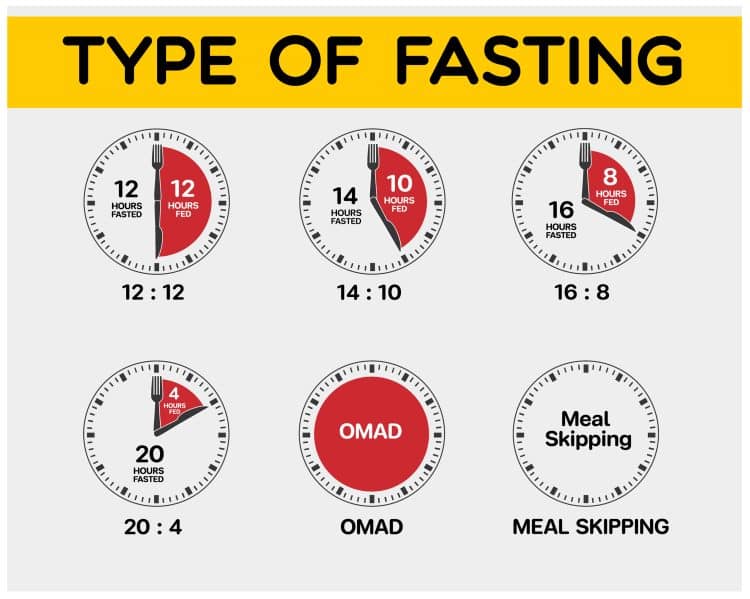What is Fasting
Fasting is a dieting method where you fast from food for a set duration of hours and only eat within a specific time frame. There are many schedules for fasting, all of which have a variety of benefits and risks.
How Fasting Affects The Body
Fasting redirects where our body’s fuel source comes from. When following a regular diet and eating consistently throughout the day, our body’s primary energy source is glucose [1]. When fasting, the body begins to utilize fatty acids for fuel [1]. The cycle that the body goes through when fasting is called the fed-fast cycle.
There are four stages of the fed-fast cycle [1]. The fed state, the early fasting state, the fasting state, and the starvation state [1].

The Fed State
The fed state begins right after finishing a meal and continues till about 3 hours after eating [1]. During this time, glucose rises, which leads to insulin secretion [1]. Glucose fuels the body, and the body uses it for energy [1]. Once the body has enough glucose to use for fuel, the body stores the extra caloric intake in adipose tissue (body fat) [1].
The Early Fasting State
The early fasting state occurs from 3 hours to 18 hours after eating [1]. Your insulin levels fall, and your body begins to convert glycogen from the liver into glucose for energy [1, 2]. Then, your body beings lipolysis, which means fat cells and fatty acids begin to be broken down for fuel [1].
Level Up Your Fitness: Join our 💪 strong community in Fitness Volt Newsletter. Get daily inspiration, expert-backed workouts, nutrition tips, the latest in strength sports, and the support you need to reach your goals. Subscribe for free!
The Fasting State
The fasting state begins about 18 hours after eating and continues till 36-48 hours after eating [1]. At approximately 24 hours, the body starts transitioning into ketosis [1, 3].
Being in a state of ketosis means that your glycogen stores are depleted, and the body begins breaking down fat for energy [1]. When fat is used as the body’s fuel source, fat loss and body composition changes result [3].
The Starvation State
The starvation state begins approximately 48 hours after eating food [1]. In this stage, glycogen stores are completely depleted, and insulin continues to decline [1]. The kidneys then begin to generate sugar through gluconeogenesis to fuel the brain [1]. The breakdown of amino acids is halted to preserve muscle, and fat cells remain the only fuel source for the body to use for energy [1].
General Guidelines and Recommendations For Fasting
While the time schedules for fasting are different for each fasting diet, some guidelines and recommendations are consistent for all fasting diets.
Maintaining a healthy and balanced diet before and after fasting is important. While there are no guidelines for what to eat when doing a fasting diet, there are consequences of eating unhealthy. Binge eating before and after fasting can negatively affect the metabolic response to fasting [2]. You should eat your recommended daily caloric intake before fasting [2]. The USDA guidelines suggest that men should consume between 2,400 to 3,000 calories per day, and females in the same age group should eat between 1,800 to 2,400 calories per day [4]. Nutritious foods should be consumed, such as whole grains, lean protein, fruits, vegetables, and nuts [4]. Added sugars, alcohol, and saturated fats should be avoided [2, 4].
Drinking water is extremely important when fasting to avoid dehydration [2]. The amount of water you should drink depends on many factors, such as the climate or your activity level [5, 6]. But, the general guideline is for adult males to drink between 3-3.7 liters of water per day and adult females to drink 2.2 – 2.7 liters of water per day [5, 6].
During the fasting period, especially if it is a long time, you should consider avoiding strenuous physical activity because fasting can the risk of fatigue and dizziness [2].
Overall, fasting diets are safe for healthy individuals as long as they are not underweight [2, 7]. Healthy individuals typically only experience mild side effects that may occur in healthy individuals, such as dizziness, weakness, irritability, headaches, and hunger [7, 9].
Those who are pregnant or breastfeeding and adolescents should avoid fasting diets because they require regular meals to maintain essential nutrients [2, 8].
Individuals who have been diagnosed with eating disorders, or are at risk of developing an eating disorder, should avoid fasting diets [2, 8]. Fasting diets can increase a fixation with food, increase self-restrictive habits, and promote binge eating behaviors [8, 11].
Lastly, fasting diets are not recommended for individuals with type 2 diabetes [2, 7, 8, 10]. Fasting greatly increases the risk of hypoglycemia, especially for those who take glucose-lowering medications [2, 7, 8, 10].
Comparison of Fasting Schedules
Clinical trials have not yet determined the best fasting diet schedule for weight loss and health benefits [7]. Since there is no conclusive evidence, let’s compare the methods, health benefits, health risks, and pros and cons to determine which may be best for you individually.
16:8 Intermittent Fasting
Method: 16:8 intermittent fasting means that you fast from food for 16 hours of a 24-hour day and then eat within an 8-hour window. It is recommended that you consume healthy and nutrient-rich foods and eat your daily recommended calories for maintaining weight as it is not a calorie-restrictive diet.
Sample Schedule:
- Day 1: Begin fast at 8 PM
- Day 2: Continue fasting until 12 PM. Eat as normal from 12 PM till 8 PM. Begin Fasting again at 8 PM.
- Following days: Follow the same schedule as the day before.
Pros:
- Easy to follow.
- You can easily eat three meals and snacks within the eating window.
- You can easily meet your daily calorie recommendations.
- It is flexible and can fit into most people’s daily schedules.
- Many research studies show that 16:8 intermittent fasting delivers weight loss benefits [13, 14, 15].
- It may help you maintain musical mass even if you lose weight [12].
- It may reduce your cravings and decrease your desire to snack [14, 15]
- It could improve fasting glucose [15].
- It could decrease biomarkers of chronic diseases [7, 8, 15, 16, 17,]
- It may improve your sleep [16].
Level Up Your Fitness: Join our 💪 strong community in Fitness Volt Newsletter. Get daily inspiration, expert-backed workouts, nutrition tips, the latest in strength sports, and the support you need to reach your goals. Subscribe for free!
Cons:
- You may experience hunger and fatigue while your body adjusts to fasting.
Who Is It Best For: 16:8 intermittent fasting is best for healthy individuals who are looking to try intermittent fasting for the first time or for those who want to practice intermittent fasting for a long duration of time.
20:4 Intermittent Fasting
Method: When you do 20:4 intermittent fasting, you fast food for 20 hours of a 24-hour day, and then you eat within a 4-hour window. 20:4 intermittent fasting is not meant to be calorie-restrictive, so it is recommended that you consume your daily recommended caloric intake in your eating window.
Sample Schedule:
- Day 1: Begin fasting at 7 PM.
- Day 2: Continue fasting until 3 PM. Eat as usual from 3 PM till 7 PM. Begin fasting again at 7 PM.
- Following days: Follow the same schedule as the day before.
Pros:
- There are no calorie restrictions.
- Studies show that you may lose weight as a result of 20:4 fasting. Weight loss may be due to ketosis or a caloric deficit, as it may be hard to consume recommended calories for maintenance [13, 14, 15, 17].
- It may result in lean muscle retention [12].
- You may have an improved glycemic response and improved fasting glucose [10, 15].
- It may offer increased protection against chronic disease [7, 16].
- It may improve your cognitive functioning [17].
Cons:
- Fasting for 20 hours may take some time to adjust to.
- It may be very difficult to consume your daily recommended calories in 4 hours.
- The 4-hour eating window may be too strict.
- It may be too difficult to continue long-term.
- There is an increased risk for hypoglycemia for those with type 2 diabetes [7, 8, 10].
- Increased risk for eating disorders [7, 8].
Who Is It Best For: 20:4 intermittent fasting is best for those who have practiced other forms of fasting, such as 16:8 intermittent fasting, before attempting. Those who have practiced fasting prior may have an easier time adhering to the diet. It is also best for those who do not mind eating a large quantity of food within a short time frame.
Alternate-Day Fasting
Method: Alternate-day fasting, as the name states, is when you fast on alternate days of the week. It is different from other fasting diets because you are allowed to eat 25% of your daily caloric intake on fasting days. On non-fasting days, you are allowed to eat ad libitum, meaning you can eat as you please.
Sample Schedule:
- Day 1: ad libitum (eat without restrictions)
- Day 2: 25% kcal (of normal daily intake)
- Day 3: ad libitum
- Day 4: 25% kcal
- Day 5: ad libitum
- Day 6: 25% kcal
- Day 7: ad libitum
Pros:
- You can eat some food on fasting days.
- There is no restriction on what foods you can eat on fasting days.
- There is strong evidence that alternate-day fasting results in weight loss [16, 18, 19, 20, 21, 22].
- Studies show that you may experience changes in body composition [18].
- It may improve your cardiovascular health, reduce your blood pressure, and reduce your heart rate [ 16, 18, 19, 22, 24].
- It may improve symptoms of asthma because fasting reduces inflammation [21].
Cons:
- You may be hungry on fasting days.
- The total fasting duration could extend for over 30 hours, depending on when you begin eating on fasting days.
- Only being able to consume 25% of daily calories may be difficult.
- There is an increased risk of hypoglycemia for those with type 2 diabetes [10].
Who Is It Best For: Alternate-day fasting is best for those who want to try a fasting diet that allows you to consume some food on fasting days.
5:2 Fasting Diet
Method: 5:2 fasting is similar to alternate-day fasting. You eat like normal for five days of the week and fast for two days of the week. On fasting days, you are allowed to consume some food, typically 400 – 500 calories.
Sample Schedule:
- Day 1: ad libitum (eat without restrictions)
- Day 2: 400-500 kcal
- Day 3: ad libitum
- Day 4:ad libitum
- Day 5: 400-500 kcal
- Day 6: ad libitum
- Day 7: ad libitum
Pros:
- You get to eat some food on fasting days
- Five days of the week are unrestricted
- Several studies show that their are weight loss benefits for 5:2 fasting [13, 14, 16, 17, 18, 19, 20, 21, 22, 25]
- It can decrease biomarkers of chronic diseases [7, 8, 15, 16, 17]
- It may improve inflammatory markers [7, 16]
- It may lead to a significant reduction in insulin concentration [10, 15, 16, 25]
- It may improve your sleep [16]
- It may improve your cognitive abilities [17].
Cons:
- You may still be hungry on fasting days.
- There is an increased risk for hypoglycemia for those with type 2 diabetes on fasting days [7, 8].
- There is an increased risk for eating disorders due to restrictions on fasting days[7, 8].
Who Is It Best For: 5:2 fasting is best for those who want to try fasting yet still are allowed to consume some calories while fasting. This could also be a great transitional fasting diet that can prepare you to do alternate-day fasting.
Periodic Fasting (24-hour fast once a week)
Method: Periodic fasting is where you fast for a full 24-hour period once per week. On the fasting day, no calories are allowed, only water or zero-carb beverages. All other days of the week are unrestricted.
Sample Schedule:
- Day 1: ad libitum (eat without restrictions)
- Day 2: ad libitum till 1 PM
- Day 3: Fast until 1 PM
- Day 4: ad libitum
- Day 5: ad libitum
- Day 6: ad libitum
- Day 7: ad libitum
Pros:
- It is more sustainable than other diets because you only fast once per week.
- The day and time window for fasting is flexible. You can choose any 24 time period during the week.
- There are no food restrictions throughout the week.
- There is a possibility of weight loss if caloric deficit for the week [18, 28].
- It may lead to fat loss if you enter into a state of ketosis [3, 17].
- It may decrease the risk of chronic disease [3, 7, 27].
- It may improve blood sugar and decrease insulin in the following morning [3, 10, 15, 26].
- May improve memory and cognitive performance [17, 27].
Cons:
- It may be difficult to fast for 24 hours without practice.
- It may increase the risk of binge eating [11].
- Doing a 24-hour fast may not be effective for weight loss if you overconsume on other days of the week [18, 28].
- You may only experience water weight loss during fasting.
- It could increase the risk of hyperglycemia for those with type 2 diabetes [7, 8, 10].
Who Is It Best For: Periodic fasting is best for those who find it difficult to fast every day or on alternate days. Fasting once a week can be just as beneficial for those with busy schedules for a social life that makes it difficult to fast more often.
One Meal A Day Diet
Method: The one meal a day fasting method consists of fasting for 23 hours of a 24-hour day and eating your entire amount of daily calories in a 1-hour window.
Sample Schedule:
- Daily: Fast until 5 PM and eat one giant meal that includes all of your daily calories. Stop eating a 6 PM.
Pros:
- There are no calorie restrictions.
- The 1-hour window for eating can occur at any time of the day (at the same time every day)
- Weight loss and body composition reductions can occur even when consuming daily caloric intake in 1 hour [29, 30, 31, 32]
Cons:
- It may be difficult to eat your daily recommended caloric intake in 1 hour.
- There is a possibility that eating so much food in one sitting can increase total cholesterol, LDL cholesterol, and HDL cholesterol [29, 30, 31, 32].
- It may cause elevated blood pressure [29, 30].
- It may cause an impaired or delayed insulin response [30, 31].
- It can increase the risk of eating disorders, such as binge eating [11].
- You may experience extreme hunger while fasting until mealtime [29]
Who Is It Best For: The one meal a day fasting schedule is best for people with busy schedules who do not mind eating all their daily calories in one huge meal.
Which Fasting Schedule is the best?
Overall, 16:8 intermittent fasting is the best overall. Most fasting diets offer the same benefits, but 16:8 is by far the least restrictive to follow. But, research has not yet discovered which fasting schedule is the best. Whichever fast you choose, it is best to listen to your body and find the fasting schedule that works best for you.
Learn everything about fasting
- How Long Until Intermittent Fasting Works? A Realistic Timeline for Results
- When Does Your Body Start Burning Fat with Intermittent Fasting?
- 14/10 Intermittent Fasting: The Simple Hack for Better Health and Weight Loss
- The Ultimate Guide to Alternate-Day Fasting: Boost Metabolism, Lose Weight, & Feel Great
- Intermittent Fasting and Exercise: Should You Work Out on an Empty Stomach?
- 6 Surprising Facts About Meal Timing and Metabolism
- Forget Eating Before Workouts — Do Fasted Training for Increased Fat Oxidation
- Is Intermittent Fasting Safe for You? Here’s What the Experts Say
- Is Fasted Cardio in the Morning Effective? Here’s What the Experts Say
- What Are the Long-Term Effects of Intermittent Fasting? Here’s What the Experts Say
- How Much Fasting Is Too Much?
- The Role of Fasting in Bodybuilding: Benefits and Drawbacks
- 7 Nutritionist Approved Intermittent Fasting Plans for Beginners You’ll Wish You’d Known About Sooner
- 6 Nutritionist Approved Meal Ideas for Breaking Your Intermittent Fast You’ll Wish You’d Known About Sooner
- Benefits of a 72 Hour Fast: Unlock Cellular Repair, Weight Loss, and Lower Blood Sugar Levels
FAQ
What is the best fasting schedule to lose weight?
Every fasting schedule results in weight loss if done correctly. For weight loss to occur, the fasting window needs to be followed consistently. You must eat a healthy and nutritious diet and not consume more than your daily recommended caloric intake when you are allowed to eat.
Does sleeping count as fasting?
Yes! The hours that you spend sleeping count as fasting hours.
What is the healthiest way to fast?
The healthiest way to fast is to ease yourself into fasting. Start with an easier schedule, such as 16:8 intermittent fasting, before you try to fast for 24 hours or more. Remember to eat healthy and nutritious foods before and after fasting to make the metabolic shift easier on your body.
What can you have while fasting?
What you can have while fasting depends on the diet you are following. If you are required to fast from food, you may drink water and other zero carbohydrate beverages while you are fasting. If you are allowed to consume some calories while fasting, you should stick to nutrient-dense foods.
How long is it best to fast for?
Research does not say how long it is best to fast for. Some fasting schedules may be easier to follow for a longer duration of time than others. It would be best to listen to your body and stop fasting if you experience any side effects.
Wrapping Up
When comparing fasting schedules, it is clear that they all have similar risks and benefits. There is no clear winning fasting schedule that will work for everyone. Find what one works best for you. Before beginning a new fasting schedule, or if you experience any side effects, make sure to speak with your doctor.
References
- Stockman, M. C., Thomas, D., Burke, J., & Apovian, C. M. (2018). Intermittent Fasting: Is the Wait Worth the Weight? Current Obesity Reports, 7(2), 172–185. https://doi.org/10.1007/s13679-018-0308-9
- Attinà, A., Leggeri, C., Paroni, R., Pivari, F., dei Cas, M., Mingione, A., Dri, M., Marchetti, M., & di Renzo, L. (2021). Fasting: How to Guide. Nutrients, 13(5), 1570. https://doi.org/10.3390/nu13051570
- Anton, S. D., Moehl, K., Donahoo, W. T., Marosi, K., Lee, S. A., Mainous, A. G., Leeuwenburgh, C., & Mattson, M. P. (2017). Flipping the Metabolic Switch: Understanding and Applying the Health Benefits of Fasting. Obesity, 26(2), 254–268. https://doi.org/10.1002/oby.22065
- U.S. Department of Agriculture and U.S. Department of Health and Human Services. Dietary Guidelines for Americans, 2020-2025. 9th Edition.
- Mayo Clinic. (2020). Water: How much should you drink every day? – Mayo Clinic. https://www.mayoclinic.org/healthy-lifestyle/nutrition-and-healthy-eating/in-depth/water/art-20044256?p=1
- USGS. (2019). The Water in You: Water and the Human Body | U.S. Geological Survey. https://www.usgs.gov/special-topics/water-science-school/science/water-you-water-and-human-body#overview
- Horne, B. D. (2020). Considerations for the Optimal Timing, Duration, Frequency, and Length of an Intermittent Fasting Regimen for Health Improvement. Nutrients, 12(9), 2567. https://doi.org/10.3390/nu12092567
- Harvard: School of Public Health. (2022, May 17). Diet Review: Intermittent Fasting for Weight Loss. The Nutrition Source. https://www.hsph.harvard.edu/nutritionsource/healthy-weight/diet-reviews/intermittent-fasting/
- Hoddy, K. K., Kroeger, C. M., Trepanowski, J. F., Barnosky, A. R., Bhutani, S., & Varady, K. A. (2015). Safety of alternate day fasting and effect on disordered eating behaviors. Nutrition Journal, 14(1). https://doi.org/10.1186/s12937-015-0029-9
- Corley, B. T., Carroll, R. W., Hall, R. M., Weatherall, M., Parry-Strong, A., & Krebs, J. D. (2018). Intermittent fasting in Type 2 diabetes mellitus and the risk of hypoglycaemia: a randomized controlled trial. Diabetic Medicine, 35(5), 588–594. https://doi.org/10.1111/dme.13595
- Iqbal A, Rehman A. Binge Eating Disorder. [Updated 2022 May 1]. In: StatPearls [Internet]. Treasure Island (FL): StatPearls Publishing; 2022 Jan-. Available from: https://www.ncbi.nlm.nih.gov/books/NBK551700/
- Tinsley, G. M., Forsse, J. S., Butler, N. K., Paoli, A., Bane, A. A., La Bounty, P. M., Morgan, G. B., & Grandjean, P. W. (2016). Time-restricted feeding in young men performing resistance training: A randomized controlled trial. European Journal of Sport Science, 17(2), 200–207. https://doi.org/10.1080/17461391.2016.1223173
- Harris, L., Hamilton, S., Azevedo, L. B., Olajide, J., de Brún, C., Waller, G., Whittaker, V., Sharp, T., Lean, M., Hankey, C., & Ells, L. (2018). Intermittent fasting interventions for treatment of overweight and obesity in adults. JBI Database of Systematic Reviews and Implementation Reports, 16(2), 507–547. https://doi.org/10.11124/jbisrir-2016-003248
- Seimon, R. V., Roekenes, J. A., Zibellini, J., Zhu, B., Gibson, A. A., Hills, A. P., Wood, R. E., King, N. A., Byrne, N. M., & Sainsbury, A. (2015). Do intermittent diets provide physiological benefits over continuous diets for weight loss? A systematic review of clinical trials. Molecular and Cellular Endocrinology, 418, 153–172. https://doi.org/10.1016/j.mce.2015.09.014
- Sutton, E. F., Beyl, R., Early, K. S., Cefalu, W. T., Ravussin, E., & Peterson, C. M. (2018). Early Time-Restricted Feeding Improves Insulin Sensitivity, Blood Pressure, and Oxidative Stress Even without Weight Loss in Men with Prediabetes. Cell Metabolism, 27(6), 1212–1221.e3. https://doi.org/10.1016/j.cmet.2018.04.010
- Patterson, R. E., & Sears, D. D. (2017). Metabolic Effects of Intermittent Fasting. Annual Review of Nutrition, 37(1), 371–393. https://doi.org/10.1146/annurev-nutr-071816-064634
- Collier, R. (2013). Intermittent fasting: the science of going without. Canadian Medical Association Journal, 185(9), E363–E364. https://doi.org/10.1503/cmaj.109-4451
- Tinsley, G. M., & La Bounty, P. M. (2015). Effects of intermittent fasting on body composition and clinical health markers in humans. Nutrition Reviews, 73(10), 661–674. https://doi.org/10.1093/nutrit/nuv041
- Trepanowski, J. F., Kroeger, C. M., Barnosky, A., Klempel, M. C., Bhutani, S., Hoddy, K. K., Gabel, K., Freels, S., Rigdon, J., Rood, J., Ravussin, E., & Varady, K. A. (2017). Effect of Alternate-Day Fasting on Weight Loss, Weight Maintenance, and Cardioprotection Among Metabolically Healthy Obese Adults. JAMA Internal Medicine, 177(7), 930. https://doi.org/10.1001/jamainternmed.2017.0936
- Heilbronn, L. K., Smith, S. R., Martin, C. K., Anton, S. D., & Ravussin, E. (2005). Alternate-day fasting in nonobese subjects: effects on body weight, body composition, and energy metabolism. The American Journal of Clinical Nutrition, 81(1), 69–73. https://doi.org/10.1093/ajcn/81.1.69
- Johnson, J. B., Summer, W., Cutler, R. G., Martin, B., Hyun, D. H., Dixit, V. D., Pearson, M., Nassar, M., Tellejohan, R., Maudsley, S., Carlson, O., John, S., Laub, D. R., & Mattson, M. P. (2007). Alternate day calorie restriction improves clinical findings and reduces markers of oxidative stress and inflammation in overweight adults with moderate asthma. Free Radical Biology and Medicine, 42(5), 665–674. https://doi.org/10.1016/j.freeradbiomed.2006.12.005
- Varady, K. A., Bhutani, S., Church, E. C., & Klempel, M. C. (2009). Short-term modified alternate-day fasting: a novel dietary strategy for weight loss and cardioprotection in obese adults. The American Journal of Clinical Nutrition, 90(5), 1138–1143. https://doi.org/10.3945/ajcn.2009.28380
- Hoddy, K. K., Kroeger, C. M., Trepanowski, J. F., Barnosky, A., Bhutani, S., & Varady, K. A. (2014). Meal timing during alternate day fasting: Impact on body weight and cardiovascular disease risk in obese adults. Obesity, 22(12), 2524–2531. https://doi.org/10.1002/oby.20909
- Cui, Y., Cai, T., Zhou, Z., Mu, Y., Lu, Y., Gao, Z., Wu, J., & Zhang, Y. (2020). Health Effects of Alternate-Day Fasting in Adults: A Systematic Review and Meta-Analysis. Frontiers in Nutrition, 7. https://doi.org/10.3389/fnut.2020.586036
- Carter, S., Clifton, P., & Keogh, J. (2016). The effects of intermittent compared to continuous energy restriction on glycaemic control in type 2 diabetes; a pragmatic pilot trial. Diabetes Research and Clinical Practice, 122, 106–112. https://doi.org/10.1016/j.diabres.2016.10.010
- Albosta, M., & Bakke, J. (2021). Intermittent fasting: is there a role in the treatment of diabetes? A review of the literature and guide for primary care physicians. Clinical Diabetes and Endocrinology, 7(1). https://doi.org/10.1186/s40842-020-00116-1
- Washburn, R., Cox, J., Muhlestein, J., May, H., Carlquist, J., Le, V., Anderson, J., & Horne, B. (2019). Pilot Study of Novel Intermittent Fasting Effects on Metabolomic and Trimethylamine N-oxide Changes During 24-hour Water-Only Fasting in the FEELGOOD Trial. Nutrients, 11(2), 246. https://doi.org/10.3390/nu11020246
- Redman, L. M., & Ravussin, E. (2011). Caloric Restriction in Humans: Impact on Physiological, Psychological, and Behavioral Outcomes. Antioxidants & Redox Signaling, 14(2), 275–287. https://doi.org/10.1089/ars.2010.3253
- Stote, K. S., Baer, D. J., Spears, K., Paul, D. R., Harris, G. K., Rumpler, W. V., Strycula, P., Najjar, S. S., Ferrucci, L., Ingram, D. K., Longo, D. L., & Mattson, M. P. (2007). A controlled trial of reduced meal frequency without caloric restriction in healthy, normal-weight, middle-aged adults. The American Journal of Clinical Nutrition, 85(4), 981–988. https://doi.org/10.1093/ajcn/85.4.981
- Carlson, O., Martin, B., Stote, K. S., Golden, E., Maudsley, S., Najjar, S. S., Ferrucci, L., Ingram, D. K., Longo, D. L., Rumpler, W. V., Baer, D. J., Egan, J., & Mattson, M. P. (2007). Impact of reduced meal frequency without caloric restriction on glucose regulation in healthy, normal-weight middle-aged men and women. Metabolism, 56(12), 1729–1734. https://doi.org/10.1016/j.metabol.2007.07.018
- Dixit, V. D., Yang, H., Sayeed, K. S., Stote, K. S., Rumpler, W. V., Baer, D. J., Longo, D. L., Mattson, M. P., & Taub, D. D. (2011). Controlled meal frequency without caloric restriction alters peripheral blood mononuclear cell cytokine production. Journal of Inflammation, 8(1). https://doi.org/10.1186/1476-9255-8-6
- Meessen, E. C. E., Andresen, H., van Barneveld, T., van Riel, A., Johansen, E. I., Kolnes, A. J., Kemper, E. M., Olde Damink, S. W. M., Schaap, F. G., Romijn, J. A., Jensen, J., & Soeters, M. R. (2022). Differential Effects of One Meal per Day in the Evening on Metabolic Health and Physical Performance in Lean Individuals. Frontiers in Physiology, 12. https://doi.org/10.3389/fphys.2021.771944
















